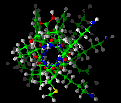 Variables and
Expressions
Variables and
Expressions Variables and
Expressions
Variables and
Expressions
set a 3.4
$a = 3.4The second example is part of the Biosym/MSI extension of TCL. Entering these commands interactively causes BTCL to print the resulting value, 3.4.
To find the value of a you can use either:
set a
echo $aAgain, entering these expressions interactively causes the current value of a to be printed. If a is undefined, however, an error message is printed. This would happen if, for example, you entered the following at the BTCL prompt:
BTCL > set a "hello"
BTCL > unset a
BTCL > set aIn general, whenever $a is encountered (where a could be any variable name), the string $a is replaced by its value. The reason echo $a is cited in the above example is because here, $a at the start of a new command line would have been interpreted as the command 3.4--which would have produced an error. This is seen more clearly in the following example script, where the commands are preceded by BTCL >, and the output is not:
BTCL > set a "echo" echo
BTCL > $a BIOSYM BIOSYMOnly the value resulting from the command processed last is printed:
BTCL > set a 3 ; $b = 4 ; set c "last set" last set
BTCL > echo $a $b $c 3 4 last setIn this example, a semicolon (;) is used to separate distinct commands that are entered on the same line.
A command line is usually ended with a carriage return. However, a command can be continued onto a subsequent line:
BTCL > set a \
{Almost
a
sentence...
}
Almost a sentence...
The last, and most important, difference
between set a and $a = is that set can take
only one value argument, but $a = can take any number of
arguments and evaluate them as an expression. Consider the following
example script:
BTCL > set a 3*4 3*4
BTCL > $a = 3 * 4 12It is important to note that the syntax $varName = something is valid only for numeric expressions. For example, $a = hello would give an error, because the expression evaluates to a string constant.
 Main
access page
Main
access page  Advanced-Use access.
Advanced-Use access.
 BTCL Language access
BTCL Language access
 Brief Introduction
Brief Introduction
 The eval and expr Commands
The eval and expr Commands
Copyright Biosym/MSI